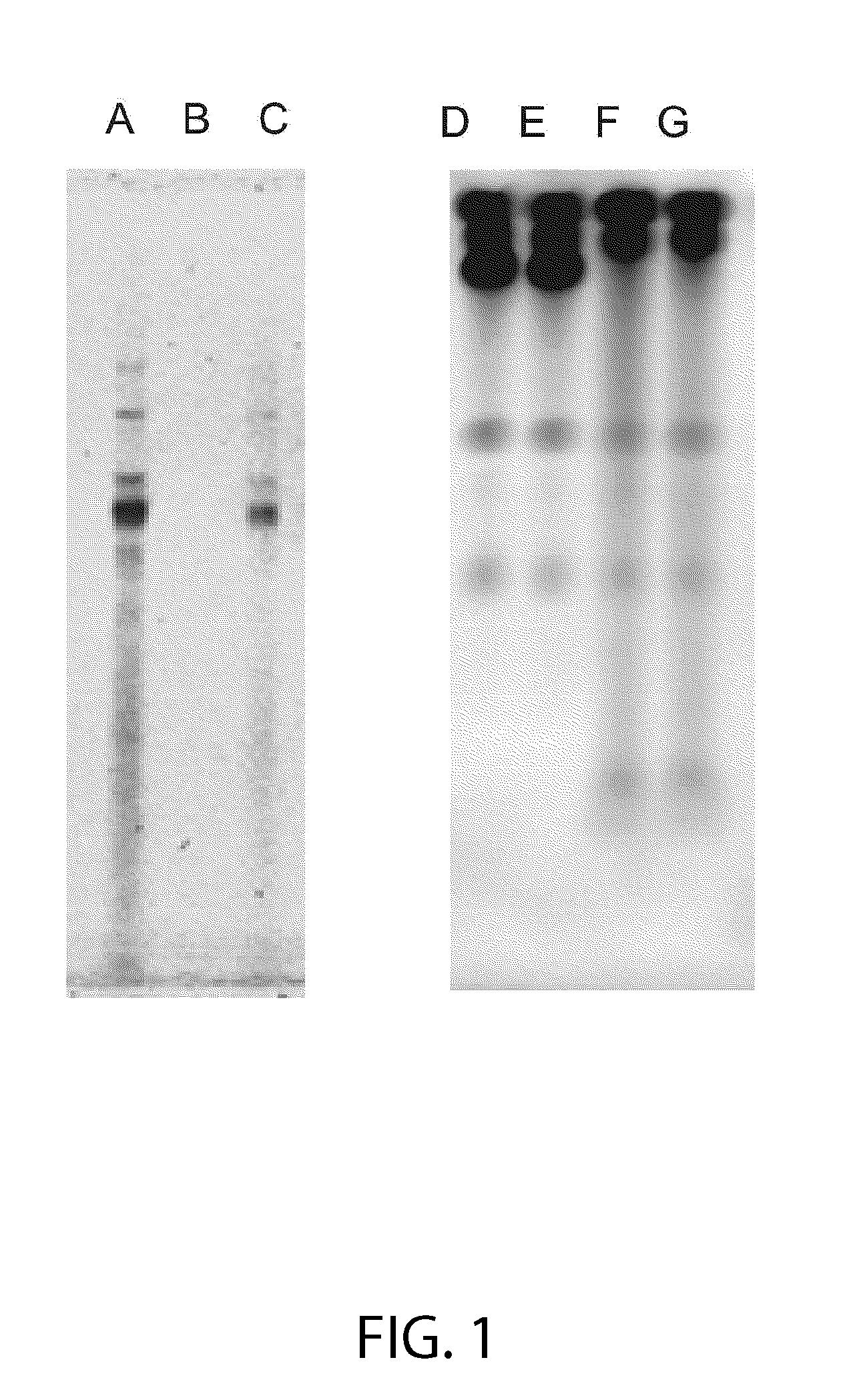Isolation of RNA
a technology of rna and rnase, which is applied in the field of nucleic acid and protein isolation, can solve the problems of rna degradation due to the presence of rnase, the biggest threat to rna isolation from eukaryotic cells, and the mrna content of a live cell can easily change during handling
- Summary
- Abstract
- Description
- Claims
- Application Information
AI Technical Summary
Benefits of technology
Problems solved by technology
Method used
Image
Examples
example 1
Total RNA Isolation from MDCK Cells
Reagents and Materials:
[0117]i) Mili-Q purified water, autoclaved after treatment with 0.1% DEPC (overnight stiffing) and 1×TE Solution made with DEPC treated water[0118]ii) RNA Elution Buffer (1×TE with DEPC water+1×RNAsecure reagent from Ambion)[0119]iii) Cell Lysis Buffer—0.1% Triton X-100+RNA Elution Buffer[0120]iv) RNAse free DNAse (PL-DNAse from Ambion) and related buffer solution[0121]v) 75% Ethanol made with DEPC treated water[0122]vi) 2-Propanol[0123]vii) 3M Ammonium Acetate Solution pH 5.2 made with DEPC treated water[0124]viii) RNAzap solution for surface cleaning[0125]ix) Lysis straws (FIG. 10), solid phase extraction straws (SPE100 straws) (FIG. 3), and Reservoirs[0126]x) Straw Machine, also known as the ERMAF, discussed in more detail below (FIG. 4).[0127]xi) Nuclease free plasticware and DEPC water treated Glassware[0128]xii) Heater to heat up RNA Elution buffer to 60° C. and heat up plate during isolation.
Procedure:
[0129]1. Rinse st...
example 2
Generation of Lysis and SPE Porous Polymer Monolyths
Materials Used:
[0151]Butyl methacrylate (99%, BuMA), ethylene dimethacrylate (98%, EDMA), methyl methacrylate (99%, MMA), 1-dodecanol (98%), cyclohexanol (99%), benzophenone (99%, BP), and 2,2-dimethoxy-2-6 phenylacetophenone (99%, DMPAP). All were purchased from Sigma-Aldrich (St. Louis, Mo.).
[0152]Oligo-DT cellulose, RNAsecure RNase inhibitor and RNAqueous kit. All were purchased from Ambion Inc.
[0153]—COOH functionalized carbon nanotubes (CNT) were obtained from ManoLab (Newton, Mass.). Specifically, multiwall, hollow structure COOH functionalized nanotubes, having a hollow structure, with an outer diameter of 15±5 nm, length 5-20 microns, were used. These were made by the manufacturer from purified multiwall carbon nanotubes (purity >95% by TGA) which have had a reflux performed in sulfuric / nitric acid to functionalize the surfaces of the nanotubes. This process resulted in a large concentration of carboxyl (—COOH) groups on th...
example 3
Generation of the Straws for RNA Purification
[0175]The straws were made up of Zeonor 690R, a polyolefin (polymer) material from Zeon Corporation (Japan). The straws were prepared (extruded) by a local company, Phi-Tech, according to our specifications. The outer diameter was about 3.18 mm and the inner diameter was either 2 mm or 1 mm. The length of the straws was about 10 cms.
Safety
[0176]a. Work inside fume hood, especially when using compressed air
[0177]b. If ever handling outside fume hood, wear Organic-vapor mask
[0178]c. Dispose of all wastes in hazardous material jars
Anneal
[0179]a. Use aluminum foil as a “tablet” so that straws do not sag.
[0180]b. Use only upper tray; straws may melt if left on lower tray.
[0181]c. Leave straws in ovens (on the aluminum foil)
[0182]d. Temp=165° C.
[0183]e. Time=60 min
[0184]f. Turn oven off and let the door closed for several hours
Load
[0185]a. Clean a bent Allen Key with Ethanol, and use it to scratch the inside of the straws for about ½ inch using...
PUM
| Property | Measurement | Unit |
|---|---|---|
| pressure | aaaaa | aaaaa |
| pH | aaaaa | aaaaa |
| pressure | aaaaa | aaaaa |
Abstract
Description
Claims
Application Information
 Login to View More
Login to View More - R&D
- Intellectual Property
- Life Sciences
- Materials
- Tech Scout
- Unparalleled Data Quality
- Higher Quality Content
- 60% Fewer Hallucinations
Browse by: Latest US Patents, China's latest patents, Technical Efficacy Thesaurus, Application Domain, Technology Topic, Popular Technical Reports.
© 2025 PatSnap. All rights reserved.Legal|Privacy policy|Modern Slavery Act Transparency Statement|Sitemap|About US| Contact US: help@patsnap.com



